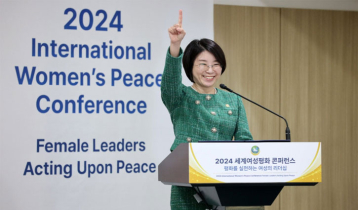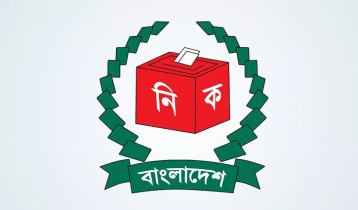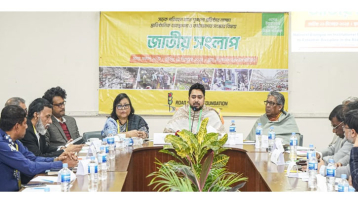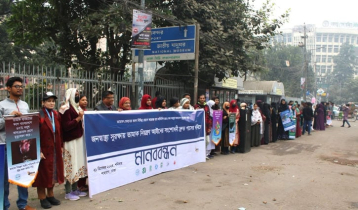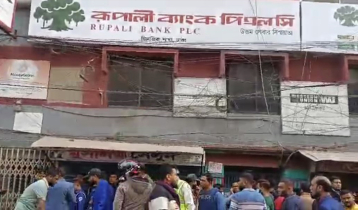The Product of the Year
Mohammed Shahjalal || risingbd.com

Every year, while inaugurating Dhaka International Trade Fair (DITF), a product/sector is declared as ‘Product of the Year’. Earlier Leather & Leather Goods, Pharmaceutical Products, Agricultural & Agro-processed Products, Light Engineering Products, IT & IT Enabled Services were declared for 2017, 2018, 2019, 2020 and 2022 respectively. Due to Covid-19 pandemic Export Promotion Bureau (EPB) could not organize DITF in 2021 and no product was selected for that year. The principal objective is to emphasize on a particular product or a sector and to take steps for developing the same so that the particular product can be made ready for marketing internationally. At the inaugural speech of the 27th edition of DITF, the Honourable Prime Minister declared Jute Product as the Product of the Year for 2023. Subsequently the Golden Aansh (Jute) was identified as an agricultural product which was published in the Bangladesh Gazette on the 23rd February, 2023. Thus jute has got the utmost importance for development and diversification during this year.
Before liberation war of Bangladesh the leading jute mill owners were the families of Bawani, Adamjee, Ispahani and Daud. There was a good number of small units too. After independence the government established BJMC in 1972 to control the affairs of these Jute Mills. Nowadays at least 220 private jute mills are in operation. Many companies do not have jute mill but they are manufacturing jute goods to meet the domestic demands and export to the overseas markets.
In our school life, teachers used to ask us to write paragraphs or essays on the golden fibers of Bangladesh. It also had to be memorized for the exam. Jute was considered as the most important cash crop of Bangladesh as a lot of foreign exchange was earned against the export of this product. Apart from the economic importance, the jute product was given the beautiful name 'golden fiber' for its educational importance. It is a matter of great concern that the export of this valuable commodity is not increasing at a significant rate. The rise of production and marketing of plastics around the world is eroding the position of jute products. If this trend continues we will not be able to insulate ourselves from poor turnover in exports along with health and environmental hazards.
Everything in jute is useful in some way. Jute leaves, bark and jute sticks are so essential that they are not unknown in rural areas. Jute leaves, barks and jute sticks are used for various purposes. From a commercial point of view, different types of bags produced from jute, tops the list. The size of the global market of jute bags grew from $ 2.26 billion in 2022 to $ 2.59 billion in 2023 at a compound annual growth rate (CAGR) of 14.3%. Growth of most of the economies got hampered due to the COVID-19 pandemic and Russia-Ukraine war. Yet the market size of jute bags is expected to grow to $3.84 billion in 2027 at 10.4% [IMARC Group]. In Bangladesh the contribution of jute industry to the GDP is 1% but in the overall export earnings it contributes 3%.
Two types of jute are grown in our country namely white jute (Corchorus capsularis) and dark colored jute (Corchorus olitorius). Bangladesh ranks 2nd in jute production in the world but ranks first as an exporting country (2022). 95, 108, 146, 133, 72, 59, 310 thousand metric tons of jute have been produced from 2014 - 2015 financial year to 2020 - 2021 respectively. The demand for jute and jute products in the domestic and international markets is increasing steadily. Jute, being a labour-intensive sector, it is possible to increase the scope of employment in production, processing, marketing and exporting here.
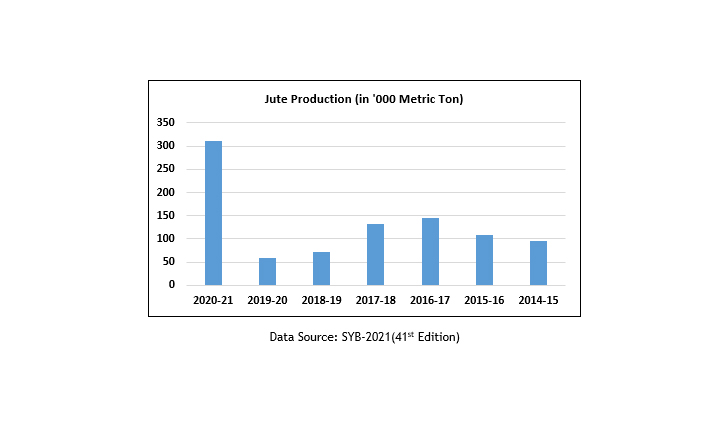 Bangladesh produces 285 products from jute and exports them to the world market. Major products include raw jute, jute hessian, bags, sacks, ropes, jute twine, jute yarn, carpets, caps, mats, carpet backing cloth, packing materials, wrapping cloth, tapestries, fruit baskets, pen cases, wallets, curtains, chair covers, jute sheets, jute yarn waste, tarpaulins, canvas, hydrocarbon free jute fabrics, geotextiles, pulp and paper, household products and non-woven textiles etc. Jute sticks are a major source of fuel in the rural areas of Bangladesh. Healthy drink made from jute leaves is now an export potential product which continues to develop. This drink has already been proven effective in controlling diabetes. Currently sarees, shirts, punjabis, shoes, sandals, briefcases, files, folders, diaries etc. are also being made from jute.
Bangladesh produces 285 products from jute and exports them to the world market. Major products include raw jute, jute hessian, bags, sacks, ropes, jute twine, jute yarn, carpets, caps, mats, carpet backing cloth, packing materials, wrapping cloth, tapestries, fruit baskets, pen cases, wallets, curtains, chair covers, jute sheets, jute yarn waste, tarpaulins, canvas, hydrocarbon free jute fabrics, geotextiles, pulp and paper, household products and non-woven textiles etc. Jute sticks are a major source of fuel in the rural areas of Bangladesh. Healthy drink made from jute leaves is now an export potential product which continues to develop. This drink has already been proven effective in controlling diabetes. Currently sarees, shirts, punjabis, shoes, sandals, briefcases, files, folders, diaries etc. are also being made from jute.
Jute products give the users a touch of nature and instill a sense of love for nature. The cuttings are very tender and can be used as a vegetable. This vegetable is very popular in Bangladesh for its taste and medicinal properties. Jute bags and ropes are very strong and durable products. Fashionable products made of jute attract people easily. Excellent souvenirs made of jute are very popular and jute goods have great demand both in the domestic market and in the overseas market.
Jute is soil-friendly and jute products are recyclable because of its compostable and bio-degradable qualities. Jute plants grow quickly and do not require much water. During the jute growing season, one hectare of jute releases up to 11 tonnes of oxygen and purifies the air. It improves soil quality and reduces the risk of pests and diseases. Jute cultivation does not require a lot of fertilizers, herbicides and pesticides. Only crop rotation is recommended for increasing soil fertility, more and better production in future.
Now let's see why we should strengthen our relationship with jute in place of plastic. Research shows that plastic bags kill about 1 lakh aquatic animals every year, including whales, dolphins, turtles and penguins. They accidentally swallow plastic bags as food. Plastic bags are not biodegradable. Scientific analysis has revealed that it may take 2,000 years to decompose plastic completely. This means that no plastic product will be seen to decompose even in our next 20 generations. It takes 60-100 million barrels of oil to make plastic, which is constantly depleting global petroleum reserves. Exposure of toxic chemicals through plastic increases the risk of ulcers, asthma, brain inflammation, obesity, heart disease and certain cancers. Large quantities of plastic bags severely clog water and sewage systems and thus pollute air, water and soil. Plastic products damage the natural food chain. According to a recent report, by 2050 there will be more plastic waste than fish in the oceans. So plastic should be avoided as soon as possible. Of the 67.5 million metric tons of plastic waste, approximately 1 million metric tons enter the oceans every year. The scary news is that 9 out of 10 ocean plastic polluters are from Asia.
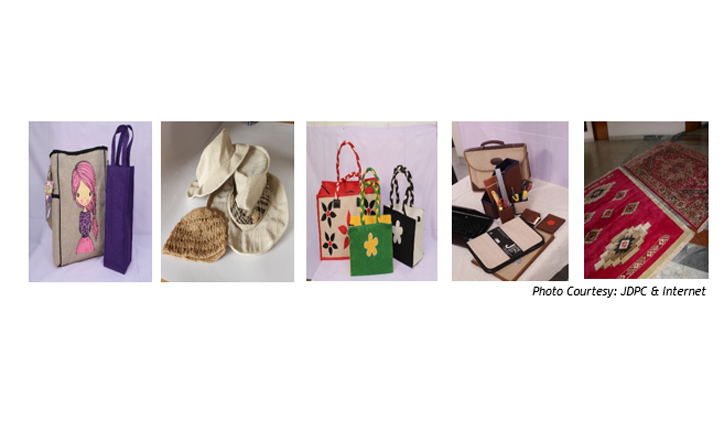 Let us have a look on the trade scenario of jute and jute goods. Apart from meeting the local demand, Bangladesh exports a wide range of jute products. Besides meeting the local demand Bangladesh exports a wide range of jute products. Major exports of jute and jute products are done under HS Codes 5303, 5307, 5310, 5603 and 6305 respectively. During the last 5 years starting from 2017-2018 the export earning against these codes were US$ 1289.95, 1078.80, 1129.03, 1537.02 and 1601.50 million respectively. Optimum production and favourable business environment can fetch more outcome against export of jute goods.
Let us have a look on the trade scenario of jute and jute goods. Apart from meeting the local demand, Bangladesh exports a wide range of jute products. Besides meeting the local demand Bangladesh exports a wide range of jute products. Major exports of jute and jute products are done under HS Codes 5303, 5307, 5310, 5603 and 6305 respectively. During the last 5 years starting from 2017-2018 the export earning against these codes were US$ 1289.95, 1078.80, 1129.03, 1537.02 and 1601.50 million respectively. Optimum production and favourable business environment can fetch more outcome against export of jute goods.
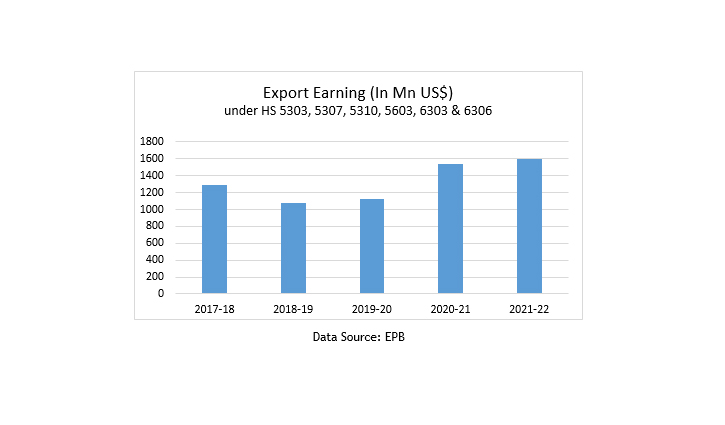 Jute products are being exported from Bangladesh to more than 100 destinations in the world. Major importing countries include Australia, Belgium, Brazil, China, Djibouti, Germany, India, Indonesia, Ivory Coast, Republic of Korea, Pakistan, Russia, United Arab Emirates, United Kingdom, United States and Vietnam. Mizoram, Tripura, Meghalaya, Manipur, Nagaland, Assam and Arunachal Pradesh, known as the Seven Sisters of India, are the largest importing partners of Bangladeshi jute and jute products. Market analysts feel that the newly imposed anti-dumping duty by the Indian government may have some adverse impact on exports to these destinations. It is expected that the formal dialogue between the two countries will be able to bring about the desired results in solving this problem.
Jute products are being exported from Bangladesh to more than 100 destinations in the world. Major importing countries include Australia, Belgium, Brazil, China, Djibouti, Germany, India, Indonesia, Ivory Coast, Republic of Korea, Pakistan, Russia, United Arab Emirates, United Kingdom, United States and Vietnam. Mizoram, Tripura, Meghalaya, Manipur, Nagaland, Assam and Arunachal Pradesh, known as the Seven Sisters of India, are the largest importing partners of Bangladeshi jute and jute products. Market analysts feel that the newly imposed anti-dumping duty by the Indian government may have some adverse impact on exports to these destinations. It is expected that the formal dialogue between the two countries will be able to bring about the desired results in solving this problem.
Realizing the importance of jute and diversified jute products, the government has declared the sector as a 'highest priority sector' in the export policy for 2021-2024 with the aim of promoting the export. Export Promotion Bureau is providing opportunities to participate in international fairs held abroad to popularize jute products and attract investors and entrepreneurs for the development of this sector. Apart from this, jute fairs are being organized locally under the initiative of Ministry of Textiles and Jute. Participation in general and product-based fairs as part of EPB's regular activities continues to serve as a strong platform to seek foreign buyers. The export policy has provision that commercial banks will encourage jute exporters to grant loans at lower rate of interest rates/service charges. An integrated action plan may be adopted and implemented for the purpose of production, diversification and expansion of export. Through this, it will be easier to identify the challenges of this sector and find ways to overcome them. The government will provide support for setting up design centers for diversified jute products. Assistance will be provided in procuring and using modern machinery for jute cultivation in a scientific manner. Government assistance is also being provided for participation in international trade fairs and exhibitions. Jute goods are now enjoying 7% - 20% cash subsidy to become competitive and sustain in the international market. Declaring ‘golden fiber (jute)’ as an agricultural product will remove ambiguity in its proper classification in customs formalities.
Various organizations including the Ministry of Commerce, Jute and Textiles, and Agriculture respectively are undertaking different action plans, studies/surveys, programme, projects, seminars, workshops, fairs and promotional activities to create public awareness for cultivation of more jute. Jute products will meet the demand of the domestic market on the one hand and export will continue on the other hand. It is the need of the hour for all concerned parties to work with a common mission to bring back the glorious heritage of our golden fibers through increased exports.
Although the jute genome or life-plan was discovered in 2010, modernization of jute varieties has not yet been able to gain momentum. It is very important to improve the yield and fiber quality of jute by inventing new varieties. Jute production sector is relatively small in size and not dependent on modern technology. High value products are not produced for developed markets such as the Middle East, the United States and the European Union. Significant success is yet to be achieved in developing the Bangladeshi brand of jute products by our entrepreneurs. Many of the entrepreneurs/traders are not familiar with international marketing channels that are widely popular in the world. Productivity in rural areas is often reduced due to natural disasters. Some entrepreneurs blame the increased cost of fertilizers, irrigation, seeds, pesticides and transportation. They also see the closure of some jute mills as the reason for the backwardness of this industry. It is not possible for the government to keep counting huge losses for years together. Whatever may be the reason, it is very necessary in the national interest to come out of the present state of our business in production and marketing of jute goods. Despite many studies on this subject, a wide gap between jute growers and middlemen/marketers is still evident. Implementation of various research recommendations often appears to be a long-term issue.
It is worthy to mention that National Jute Policy-2018 has been declared by the government with some strategic priorities like production of quality jute, ensuring fair price of jute, diversification of jute goods, modernization of jute mills and expansion of the market of jute products. It enables the exporters to cultivate, process, produce diversified products, attract FDI and penetrate new markets globally. There is a provision to create a Technology Upgradation Fund. The Bangladesh Embassies located abroad can play a significant role in providing information on potential market and buyers. This is time to motivate our cultivators to take steps to grow jute abundantly and the business entities to restart with a congenial trading process.
Researchers, entrepreneurs, policy makers and the business community need to be encouraged to invest in finding alternatives to plastics. And if it is possible, jute will save our future generation from many unwanted risks. Jute is a golden fiber, biodegradable material, cash crop, healthy life giver and it can be the future solution to many unexpected problems.
Bangladesh has a long tradition in cultivation, use and marketing of jute and jute products. In order to improve the quality of life of the growing population of the country, people from all walks of life need to come forward with the aim of finding the proper complement to food production and healthy living. Promotion of export trade should be given top priority to create sustainable economic conditions through generating employment as well as earning foreign exchange. Considering the evils of plastic products, eco-friendly jute products need to be chosen as essential materials of daily life. On the whole, there is no alternative to work towards accelerating the development of the overall economy of the country by increasing jute cultivation, diversifying jute products, trying to save human and animal life, saving the environment from pollution, increasing foreign exchange earning capacity, creating employment and expanding exports. In this case, the participation of Bangladeshi exporters in international trade fairs can be expanded under the auspices of organizations related to the country's export promotion. Export growth can be a very effective means to create a lot of inflow of foreign exchange with the aim of being a developing country and emerging as a smart Bangladesh.
Writer: Director, Export Promotion Bureau
Hasan/AKA



